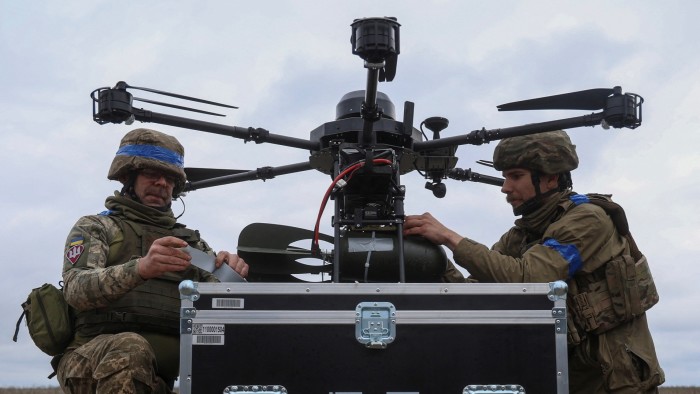Unlock the Editor’s Digest for free
Roula Khalaf, Editor of the FT, selects her favourite stories in this weekly newsletter.
In a cramped basement in Kyiv, a ragtag team of volunteers, including a florist, a professional dancer, a 77-year-old pensioner and a British ex-serviceman, are assembling drones for the Ukrainian army. Basic in design and costing $350 to manufacture, the 10-inch quadcopters boast distinctive red antenna mounts. “They call them red-arsed drones,” says Kseniia Kalmus, founder of Klyn Drones, a charity funded by donations.
In spite of the jovial mood, the workshop serves a deadly purpose. Once complete, the drones are rushed to the frontline where they are in hot demand by the military units that have commissioned them. They have rapidly become a critical component of modern warfare serving multiple purposes: surveillance, logistical support, minelaying and lethal strikes against enemy soldiers, tanks, infrastructure and ships.
More than three years after Russia launched its full-scale invasion, Ukraine remains heavily outgunned and outmanned. It still relies on its US and European allies for much of its traditional military hardware and intelligence. But it is fast emerging as a “world leader” in drone technology enabling it to continue to resist Russian aggression, says Giorgi Tskhakaia, a military adviser to the ministry of digital transformation.
“Unfortunately, Ukraine is not a very rich country so we understood that we need to have very cheap and smart solutions that can bring game-changing potential on the frontline,” he tells me.
Drones have rapidly become indispensable for Ukraine, but it is the country’s technological-industrial substructure that might prove its greatest military asset. It is an example that other European countries should study closely as they now urgently re-arm.
Battlefields are the most exacting R&D labs for any technology and the conflict has triggered a ferocious “cat-and-mouse” race to experiment fast. The Russians have a bigger industrial base, ready access to Chinese components and excel at electronic warfare that jams the enemy’s drones. But Ukraine believes it is winning the start-up war thanks to its highly adaptable network of domestic manufacturers, who benefit from immediate feedback from frontline forces, the smart use of artificial intelligence software and localisation of the supply chain.
Since 2022, the number of Ukrainian drone manufacturers has risen from four to more than 500 with capacity to produce 5mn units a year, according to Tskhakaia. With sufficient funding that could rise to 10mn, he says.
To support this army, Ukraine has accelerated its weapons approval process and provided economic and tax incentives for investors to back private sector start-ups. It has allowed frontline units to deal directly with manufacturers, speeding up innovation and delivery. It has also created the Brave1 platform to provide organisational and financial support for defence tech projects.
A research paper published last month by the Massachusetts Institute of Technology and the Kyiv School of Economics examined how Ukraine had adopted a “whole of nation” approach to mobilise civilian resources for drone development. Its defence tech cluster is driven by the interplay between five forces: start-ups; risk capital; universities; government agencies; and established defence companies.
This innovative ecosystem has enabled Ukraine to experiment with more than 100 types of drones on the battlefield, including unmanned aerial vehicles piloted through unjammable fibreoptic cables and autonomous ground vehicles to resupply frontline troops. It has developed fixed-wing kamikaze drones that have a range of more than 1,000km, enabling strikes against Moscow. And its Sea Baby and Magura naval drones have harassed Russia’s Black Sea fleet, destroying several ships, costing tens of millions of dollars.
Drones are only fully effective when combined with heavier weapons systems. A recent report from the Royal United Services Institute estimated that up to 80 per cent of drones guided by a pilot failed to reach their target. Nevertheless, the sheer volume Ukraine had deployed meant they were responsible for 60-70 per cent of all damaged and destroyed Russian systems.
Ukrainian experts suspect some military drones developed in the US and Europe risk becoming obsolete within weeks of any new conflict. Few military commands understand the constant need to adapt technology — or are structured to do so. Tskhakaia’s top three lessons from the conflict? “Technology, technology, technology. Innovation, innovation, innovation. AI, AI, AI.”
European arms manufacturers need to learn fast.
